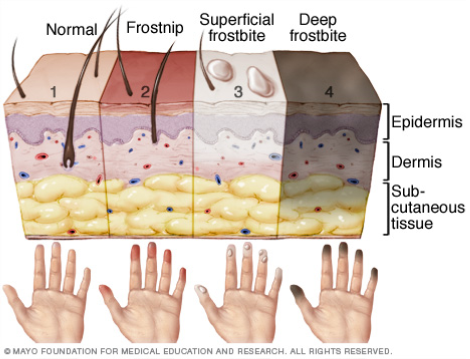- Frostnip is a mild form of frostbite, it irritates the skin, causing redness and a cold feeling followed by numbness. Frostnip doesn't permanently damage the skin.
- Superficial Frostbite appears as reddened skin that turns white or pale. The skin may remain soft, but some ice crystals may form in the tissue. Your skin may begin to feel warm — a sign of serious skin involvement. If you treat frostbite with rewarming at this stage, the surface of your skin may appear mottled, blue or purple. And you may notice stinging, burning and swelling. A fluid-filled blister may appear 24 to 36 hours after rewarming the skin.
- As Deep Frostbite progresses, it affects all layers of the skin, including the tissues that lie below. You may experience numbness, losing all sensation of cold, pain or discomfort in the affected area. Joints or muscles may no longer work. Large blisters form 24 to 48 hours after rewarming. Afterward, the area turns black and hard as the tissue dies.
Rewarming tissue is a good way to treat frostbite. Soak the affected part of the body in warm water (comfortable to the touch) until the tissue is soft and flexible but for no more than 30 minutes. Never rub or massage the affected area because that could cause more tissue damage.
It can take weeks or months to determine the true extent of tissue damage.
Exercise may help avoid frostbite because it forces blood into your extremities.
Frostbite can occur quickly with exposure to cold temperatures, particularly if they are accompanied by a low wind-chill factor or following more brief exposure to very cold temperatures.
When the temperature is at 0°F, exposed skin can freeze in 5 minutes.


 RSS Feed
RSS Feed
